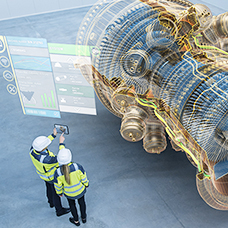 10-08-2020
10-08-2020
2020 cohort includes mixed reality, AI, and remote sensing solutions
Innovation can come from a myriad of places and to remain on the cutting edge, SAIC continually seeks out premier sources of innovation from wherever possible to meet our customers’ missions.
Techstars is a seed-stage startup accelerator that has helped get over 2,100 U.S. startups off the ground through intensive, three-month accelerator programs it has operated since 2006. SAIC is a partner in the Techstars Starburst Space Accelerator with other industry leaders like Lockheed Martin, the U.S. Air Force, and NASA Jet Propulsion Laboratory (JPL) to shape the aerospace industry’s future with solutions from the fields of artificial intelligence, geospatial analytics, robotics, autonomous systems, and other technical areas.
“The do-or-die urgency that startup companies operate with is precisely what leads to the groundbreaking innovations that our customers need,” said Matt Dew, SAIC chief solutions architect. “It is also what makes them amenable to accepting the mentorship and guidance that SAIC can offer.”
Andrew Seely, chief solutions architect and vice president in SAIC's National Security and Space Sector and Techstars program mentor, said SAIC’s involvement in the program generates a significant value exchange that couldn’t happen otherwise.
“These companies gain important contextual understanding from a partner like SAIC,” Seely said. “And our own mission benefits from a future partner that could augment our solutions and services we deliver to our customers.”
Of the 10 companies in the 2020 program cohort, SAIC is engaging in ongoing mentoring relationships with three of them: Holos Inc., Natural Intelligence Systems Inc., and vRotors.
Holos Inc.
Holos Inc. designs and develops a mixed reality content management system that is modular, scalable, and easily accessible.
Holos designs environments that are intuitive and user friendly, reducing the time it takes for users to gain familiarity with systems and increasing learning. And once the education begins, Holos programs focus on retention, with direct, tangible learning exercises that engage users and trainees more effectively.
“Virtual reality has started to enter the mainstream entertainment market, in movies like ‘Ready Player One’ and television shows like ‘Upload,’” Seely said. “As the idea gains traction in entertainment, it will become more normalized in military environments, and agencies will be more willing to consider a virtual reality product.”
Seely said SAIC is helping Holos enter the military realm by providing standards, symbology, and verbiage as the startup develops a Joint All-Domain Command and Control (JADC2) user interface.
ADDITIONAL READING: More on the partnership between SAIC and Holos
Natural Intelligence Systems Inc.
Most AI systems are based on complex, mathematical frameworks called neural nets. This is built on a theory that the human brain processes information using calculations. But we now know the human brain uses patterns to process data. So, why doesn’t artificial intelligence (AI) function the same way?
That’s the question Paul Dlugosch, CEO of Natural Intelligence Systems Inc., posed when he set out to improve AI. Rather than using algorithms, Natural Intelligence attempts to train AI using patterns, which provides better context to AI systems.
By using pattern-based learning rather than calculations, Dlugosch claims his AI systems are exponentially faster, more efficient, and more cost-efficient than current systems. Dlugosch established proof-of-concept with a government agency attempting to determine the health and security of its computer storage facility.
Dlugosch’s work is similar to AI work conducted by SAIC’s analytics practice. Our Edge Services utilize real-time human feedback to correct erroneous AI output to create more accurate future AI inferences.
vRotors
vRotors is a software enablement platform that allows users to pilot remote drones from home or office hardware. When issues crop up at remote sites like oil wells or cell towers, rather than sending people, which costs time and money, a vRotors drone can be remotely dispatched and piloted by the site manager through an intuitive user interface. A team can even virtually join to observe the inspection and help diagnose issues.
“SAIC and its customers have long needed an ability to control multiple devices remotely from multiple locations in a synchronized manner. vRotors gives that to us with application use cases in all domains from undersea to space,” said Jody Merritt, Techstars mentor and SAIC solution architect. “It’s so exciting to see an accessible JADC2 capability like this coming out of the Techstars Starburst Space Accelerator. It’s really a game changer.”
Collaborating with the cohort
Though interactions this year are assuredly unique and different from what Techstars Starburst Space Accelerator program members previously had, SAIC and its leadership are excited to continue its partnership with this valuable program to form new relationships with budding startups.
“With everything we’ve seen with this cohort, we’re excited about their aptitude and what it means for the future,” said Chitra Sivanandam, SAIC vice president of analytics. “This startup accelerator is a part of our diet of a solid source of innovation.”




